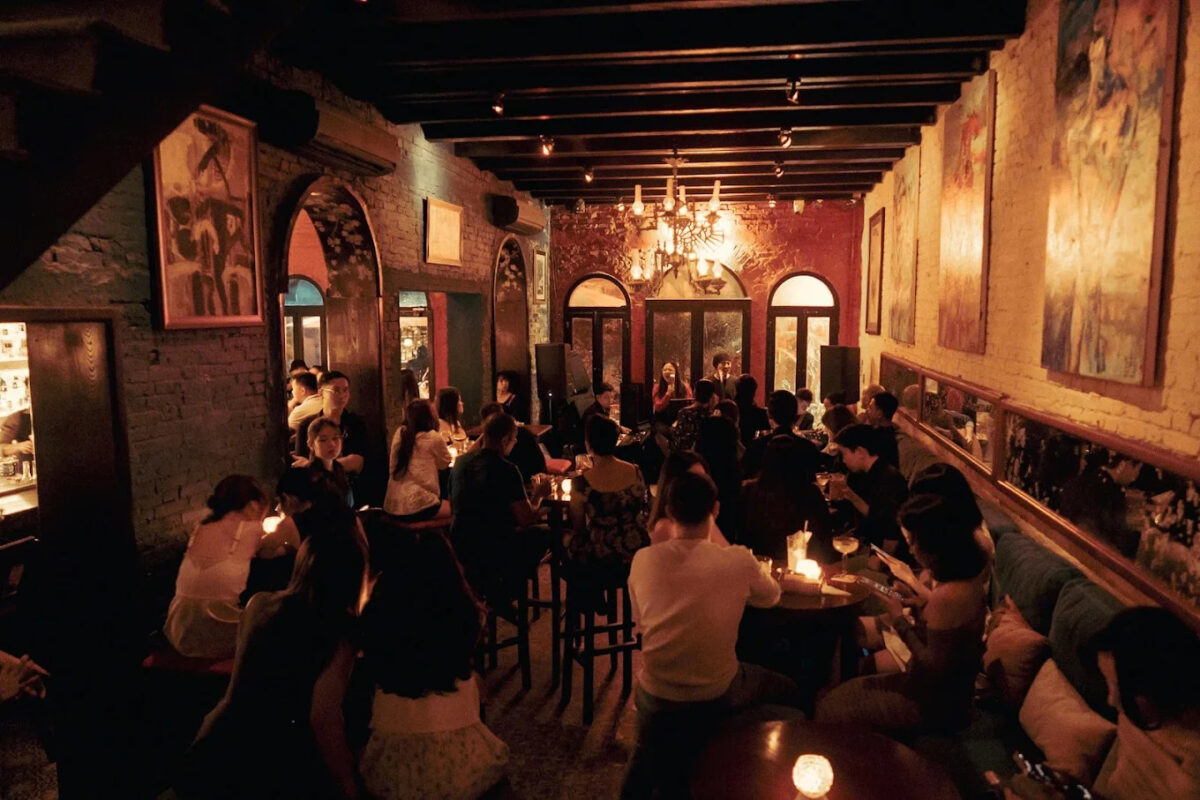The Long Bien Bridge is more than 100 years old and has a lot of history. It was built when Vietnam was under French control, and surprisingly, it survived bombings during the Vietnam War. The Long Bien Market has been around for almost 25 years and is important in the city. It collects food from the north of Vietnam and sends it to stores and restaurants in Hanoi. Let’s explore these two famous places in the article below.
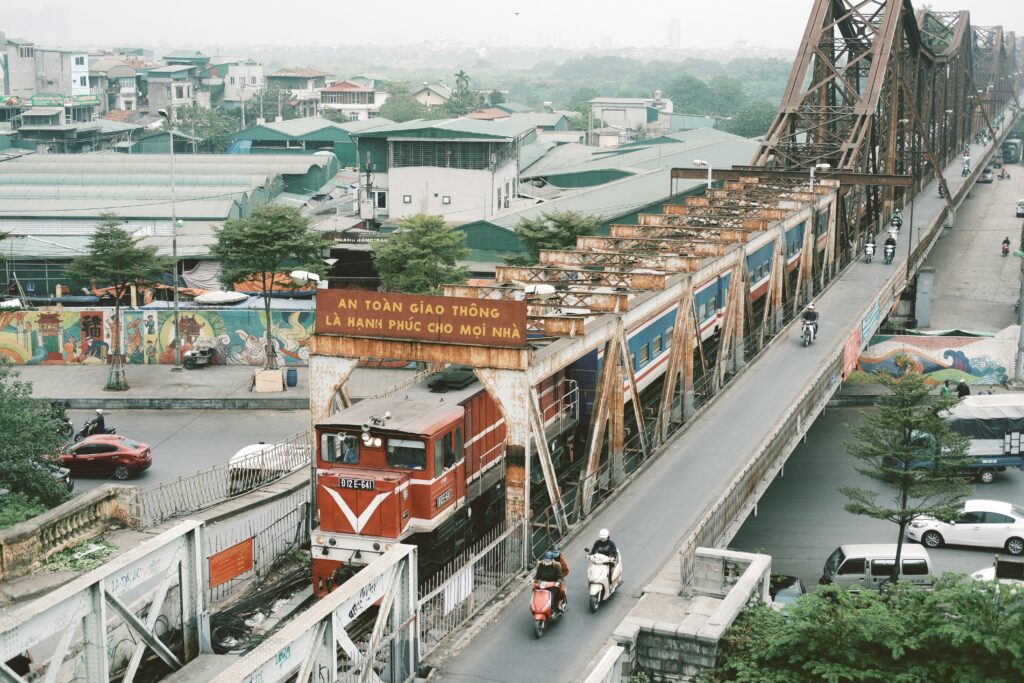
Long Bien Bridge: A Grand Old Bridge
1. Introduction to Long Bien Bridge

The Long Bien Bridge is almost 120 years old, built from 1899 to 1902 during the time when the French ruled Vietnam. Local Vietnamese workers constructed it, and it’s Hanoi’s first steel bridge. Opening in 1902, the bridge spans over 1,691 meters, with a rail track in the middle and roads on both sides. Originally named after Paul Doumer, the French Governor-General in Indochina, it got its current name in 1954 after the Vietnamese defeated the French in the Battle of Dien Bien Phu.

During the Vietnam War (1955-1975), the Americans bombed the bridge many times due to its strategic location connecting Hanoi and Hai Phong. Despite suffering damage and destruction, the bridge was consistently repaired and rebuilt. It faced a total of 14 bombings, severely damaging most of its sections.
Even after the war, the bridge remains in use. The parts repaired during the war are still functional, though the road surface shows signs of damage in several areas. Despite regular maintenance, the bridge displays increasing wear and tear.
Signs are posted, urging people to limit bridge usage. However, due to ongoing development along the Red River, thousands of motorbikes and bicycles cross the bridge daily during peak hours. Additionally, the train uses the bridge up to 20 times a day. Although plans to construct new bridges over the river have existed for years, they remain on paper without implementation.
2. Best Time to Visit Long Bien Bridge
The optimal time to visit Long Bien Bridge is during the enchanting hours of sunrise and sunset. These moments offer a picturesque spectacle as the soft sunlight bathes the bridge in warm hues, creating a serene and captivating atmosphere.
Sunrise at Long Bien Bridge:
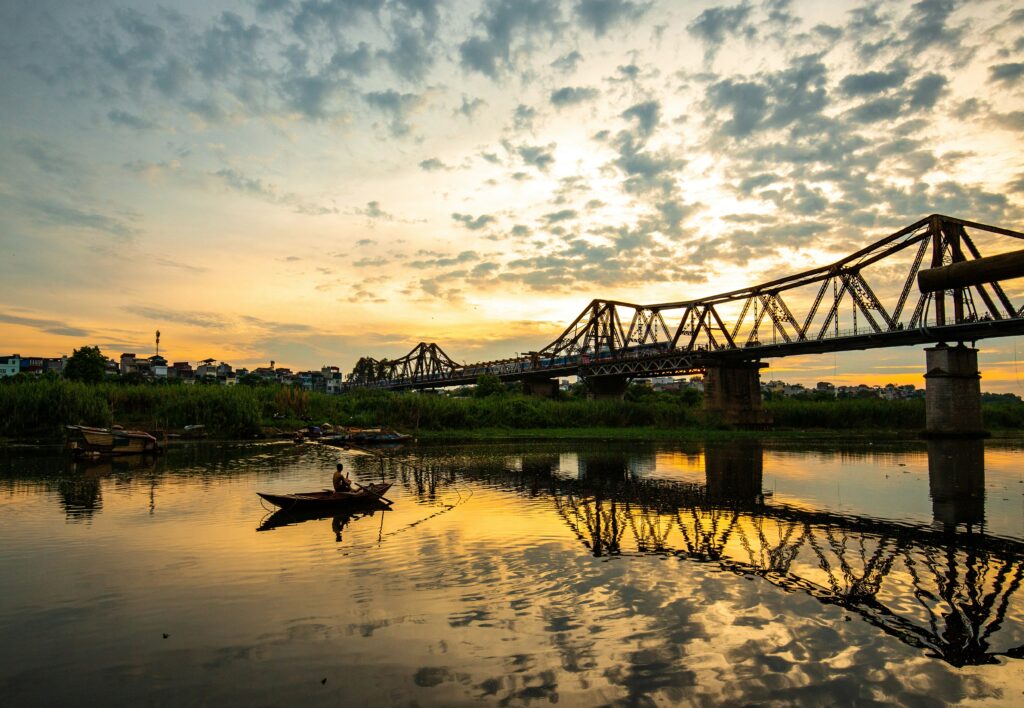
Early morning, as the sun emerges on the horizon, is a magical time to witness Long Bien Bridge. The gentle glow of the rising sun casts a golden light upon the historical structure, accentuating its architectural beauty. The tranquil ambiance during sunrise provides a serene setting for those seeking a reflective and peaceful experience.
Sunset at Long Bien Bridge:
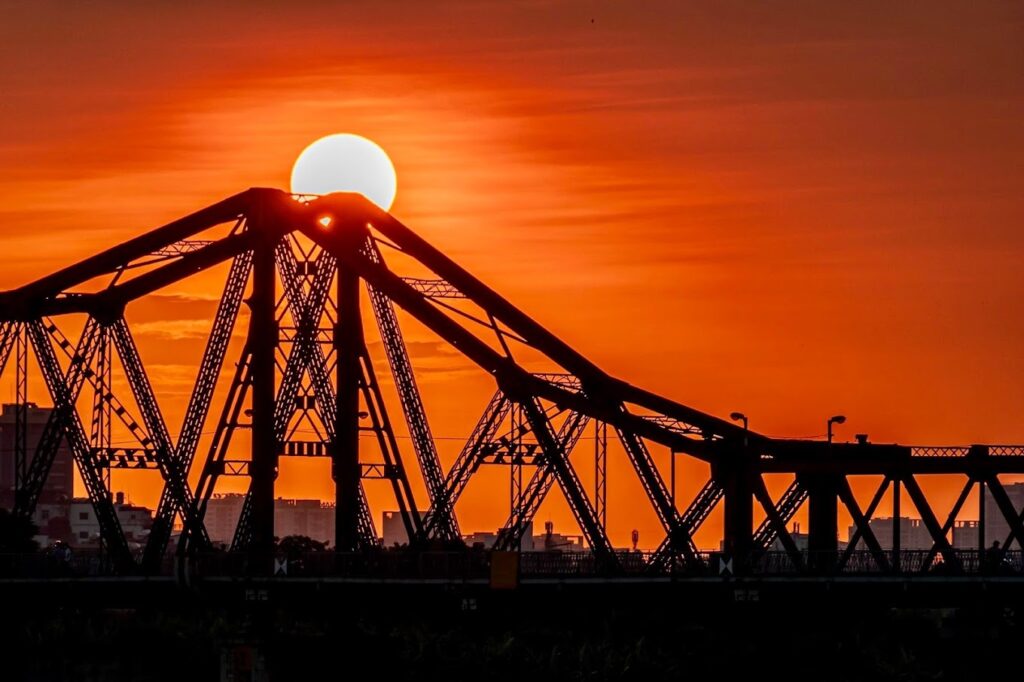
As the day comes to a close, Long Bien Bridge is bathed in the warm colors of the setting sun. The play of light and shadows on the steel beams creates a dramatic and captivating scene. Sunset at Long Bien Bridge is a time to appreciate the bridge’s endurance and to capture breathtaking moments against the backdrop of the evening sky.
Visiting during these hours not only allows for stunning photographs but also provides a unique opportunity to experience the bridge’s historical charm in a tranquil setting. Whether you are a photography enthusiast or simply seeking a quiet moment of contemplation, sunrise and sunset at Long Bien Bridge offer an unforgettable and immersive experience.
3. Getting to Long Bien Bridge from the Old Quarter:
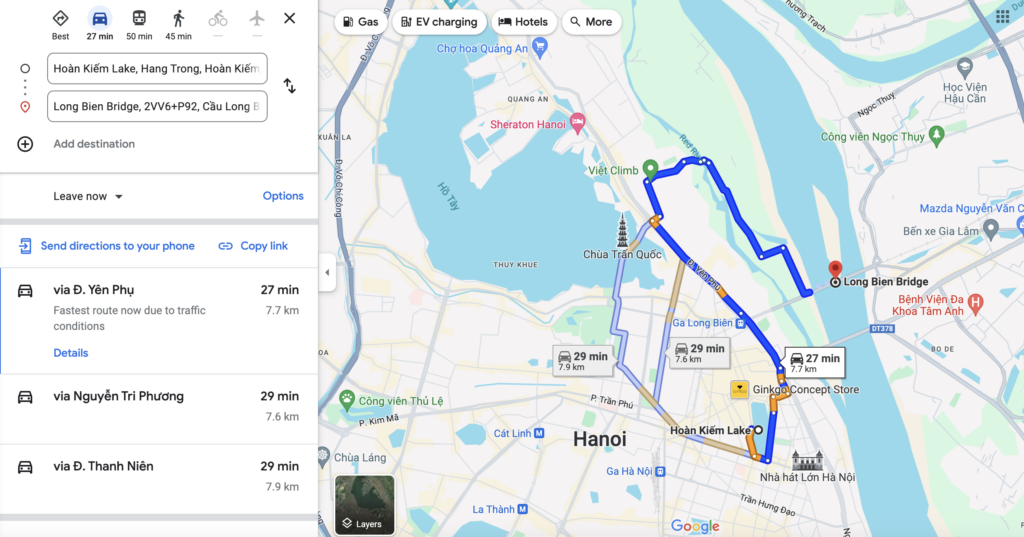
Getting from Hanoi’s Old Quarter to Long Bien Bridge is a straightforward journey, and there are several convenient transportation options available:
- Taxi or Ride-Hailing Services:
Taking a taxi or using ride-hailing services like Grab or Gojek is one of the easiest ways to reach Long Bien Bridge from the Old Quarter. Simply hail a taxi or use a ride-hailing app on your smartphone, input the destination as Long Bien Bridge, and enjoy a comfortable ride directly to your destination.
- Motorbike Taxi (Xe Om):
Motorbike taxis, known as xe om, are a popular and affordable means of transportation in Hanoi. You can easily find xe om drivers waiting along the streets of the Old Quarter. Negotiate a fare with the driver and enjoy the exhilarating ride to Long Bien Bridge, taking in the sights and sounds of the city along the way.
- Public Bus:
Hanoi’s public bus system offers routes that connect the Old Quarter to various parts of the city, including Long Bien Bridge. Look for bus stops near your location in the Old Quarter and board a bus heading towards Long Bien or Gia Lam. Be sure to check the bus schedule and route map beforehand to ensure a smooth journey.
- Walking:
For those who enjoy walking and want to explore the streets of Hanoi at a leisurely pace, walking from the Old Quarter to Long Bien Bridge is also an option. The bridge is approximately 2-3 kilometers away from the Old Quarter, depending on your starting point. Take in the sights and
Long Bien Market: A Food Adventure
Long Bien Market, nestled adjacent to the historic Long Bien Bridge in Hanoi, Vietnam, is a vibrant and bustling marketplace that has thrived for nearly a quarter of a century. This lively market is not merely a commercial hub but a cultural and culinary haven, offering a sensory journey into the heart of Northern Vietnamese life.
1. Introduction to Long Bien Market
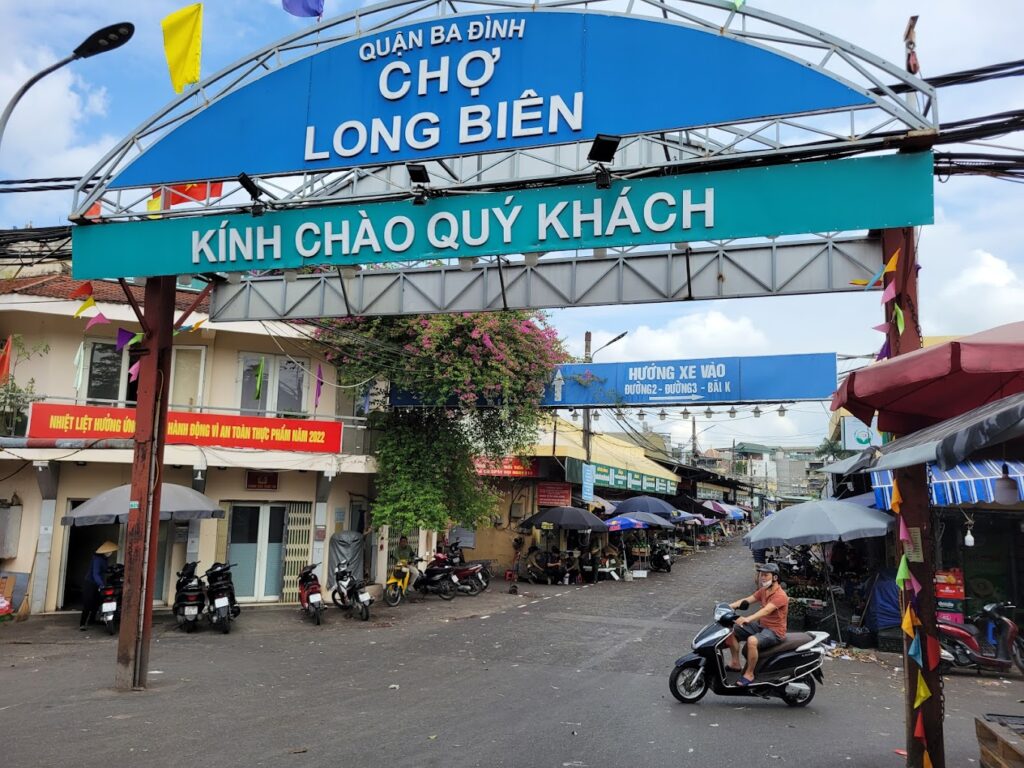
Long Bien Market boasts a rich history, mirroring the resilience and adaptability of the Vietnamese people. Established over 25 years ago, the market has become an integral part of the Red River Delta region’s economic tapestry, serving as a crucial link between local producers and the diverse array of shops and restaurants in Hanoi.
What sets Long Bien Market apart is its authenticity and the kaleidoscope of colors, scents, and sounds that greet visitors. This wholesale market is a treasure trove of agricultural products sourced from the fertile regions surrounding the Red River Delta. From fresh fruits and vegetables to rice, meat, eggs, and fish, the market offers an extensive array of local produce that reflects the agricultural richness of Northern Vietnam.
The market is a visual spectacle, with vendors skillfully arranging their wares in vibrant displays. Towering hills of freshly harvested fruits and vegetables create a lively atmosphere, making every visit an immersive experience into the agricultural bounty of the region. Despite its simplicity, Long Bien Market stands as a testament to the authentic and unfiltered way of life in Vietnam.
2. Best Time to Visit Long Bien Market:

To witness the market in its full vibrancy and witness the bustling trade activities, the optimal time to visit is during the early morning hours, typically from 2 AM to 5 AM. This is when local vendors, restaurants, and smaller markets converge to negotiate for fresh produce, creating a dynamic and energetic ambiance.
4. Getting to Long Bien Market from the Old Quarter
For those exploring Hanoi’s Old Quarter, reaching Long Bien Market is a convenient endeavor. The market is easily accessible by walking or taking a short taxi or motorbike ride, allowing visitors to seamlessly integrate this authentic cultural experience into their exploration of Hanoi.
Conclusion
In conclusion, Long Bien Bridge and Long Bien Market offer a simple yet captivating glimpse into Hanoi’s history and daily life. These places connect visitors to the authentic charm of the city. If you’re up for more adventures, don’t miss the Jackfruit Adventure, an exciting way to explore Hanoi’s unique flavors and culture Hanoi Ho Chi Minh city cycling tour by bicycles.




